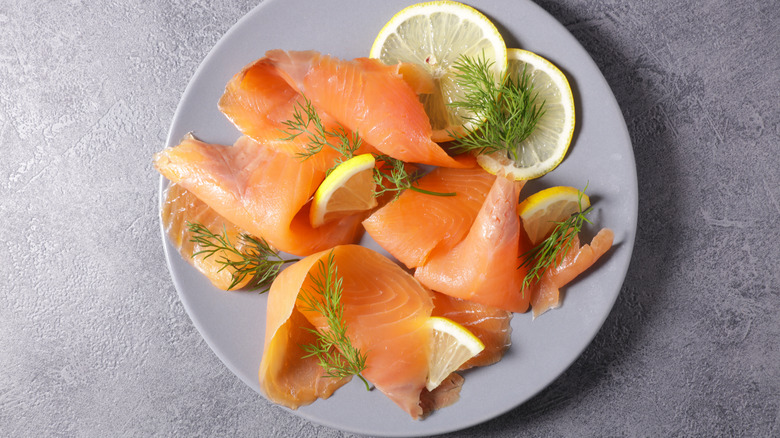Lox Vs Nova Salmon: Do You Know The Difference?
Order a bagel and lox, and your sandwich will likely be adorned with a schmear of cream cheese, red onion slivers, perhaps a sprinkle of capers, and luxurious, thinly sliced salmon. Oddly enough, you may not be served genuine lox. Look for the real deal at Jewish delis. "We're a hardcore Jewish deli," says Gary Greengrass, the third-generation owner of New York's Barney Greengrass, a century-old Upper West Side institution. Unsurprisingly, his grandfather's lox offers a taste of yesteryear — and keeping with tradition, that taste is incredibly salty.
Salt was used out of necessity in the days before refrigeration to preserve a big catch and prevent it from spoiling. However, it has the added benefit of breaking down the muscle fibers in the fish, creating a texture as smooth as butter. "It's not a smoked fish, it's a pickled fish," Greengrass says. But this is no quick pickle; the fish is brined in a vat filled with salt and water for six months, even up to a year, transforming the flavor of the salmon. "It's really salty through and through," notes Greengrass.
The extra-salty lox is what you may call an acquired taste. Greengrass cautions first-timers at his store. "A customer comes in and says, 'Give me lox and cream cheese on a bagel.' The question really is, 'Do you want lox that is salty or Nova, which is mild?' 99% are going to want it mild. The old die-hards want it salty."
What is Nova salmon?
Lox should not be confused with the similar-sounding gravlax, which is raw salmon cured for a few days with a mix of sugar, salt, dill, and other spices. Nova salmon and its roots can be traced back to the turn of the 20th century. Back then, nearly all of North America and its Jewish population enjoyed salmon from the waters of the Canadian province of Nova Scotia. To make matters even more confusing, the term Nova isn't necessarily used to indicate where the salmon originated but rather how it's prepared.
Though it is often mislabeled as lox, Nova is a type of smoked salmon. The brine for Nova salmon starts with a mixture of salt, sugar, and water. Instead of a months-long soak, the fish only spends a few days in the sweet and salty bath. In some cases, sugar is removed from the equation. In others, no water is added, and the salmon is dry-cured. During that time, the salmon will excrete some of its natural oils and absorb the salt and sugar, which yields luscious flavor and firmness.
The salmon is cold-smoked to enhance the flavor while ensuring the flesh remains velvety. Cranking the heat for a hot smoke will amp up the smoky flavor, resulting in a firmer, flakier texture. There's no mistaking mild-cured, mild-smoked Nova from the salty intensity of lox. Whether you're a one-percenter or in the smoked salmon-loving majority, it's best to double-check what you're getting.

